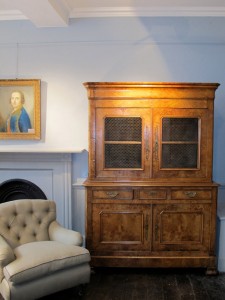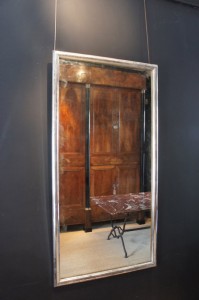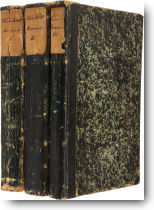[Admin Note: We receive many inquires here at antiques.com to help our users appraise their antiques. It is almost impossible (and irresponsible) to try and appraise anything via email online. Detecting the objects subtleties, imperfections, weight, smell, texture, you name it requires in person inspection. Therefore for those interested, we have the below offering from the International Society of Appraisers so you can learn the craft for yourself.]
Eight courses are scheduled for October and November including Appraisal of Fine Arts, Core Course in Appraisal Studies, Requalification Course, Advanced Report Writing, Oriental Rugs, Appraisal of Antiques & Residential Contents and the 7 hour and 15 hour Personal Property USPAP Course.
APPRAISAL OF FINE ART – October 15-20, 2012
Emphasizes the primary categories of fine art frequently encountered by appraisers and dealers: paintings, sculpture, works on paper, frames, photography, animation art, Russian icons and Spanish Colonial art. Major areas of focus: art history, looking at art works properly, identifying and researching fine art works, properly describing art works, correctly employing specific vocabulary, and art conservation. A field trip to local museums, such as The Art Institute of Chicago, provides students with close exposure to the property categories being studied. (Covered by course fee)
CORE COURSE IN APPRAISAL STUDIES – October 8-14, 2012
This is the “original” complete appraisal methodology course for personal property appraising. Its thorough scope includes appraisal objectives, intended uses, market identification and analysis, research methods and skills, ethics and professional conduct, and a detailed presentation of report formats and checklists. This course sets the standards that others imitate. The encyclopedic manual is in two sections and includes a resource directory of over 200 pages, including computer research sites, useful forms for your appraisal practice, and abridged law cases worthy of mention. The on-site class is presented in a user friendly manner with many group activities that reinforce written and visual information. Students learn the techniques of networking and are able to apply their new skills and knowledge in writing complete appraisal reports that are both ISA and USPAP compliant. Minimal computer skills are required and laptop use in the classroom is encouraged.
REQUALIFICATION COURSE-September28-29(Toronto,Ontario)and October 26-27, 2012
A review and update of ISA’s Appraisal Standards covering significant recent changes including those in the ISA Core Course Manual, the IRS, and the insurance industry. The class is a requirement for re-qualification and provides current guidelines, checklists, and forms helpful for every member. This will ensure that you are developing and writing appraisals to the current standards. Our text is the current edition of the ISA Core Course Manual and much class time is spent in discussion and group activities. No exam is given and students are dismissed at the end of the second day.
ADVANCED REPORT WRITING – October 24-25, 2012
This two day class is for all appraisers who are seeking to enhance and advance their report writing skills. Attention is given to forming persuasive arguments in writing defendable reports. We also cover complex, multiple value, and broad evidence appraisals and the choices we have in formatting and presentation. Time will be spent on appraisal software and technology in presenting great looking reports. Another section will explore appraisal reviews and how to write them. This will include peer review of two appraisal reports that each student will bring. You will be encouraged and challenged. The class will give you many ideas and tips that will benefit you no matter how long you’ve been in the profession. Bring laptop computer.
ORIENTIAL RUGS COURSE – November 9-10, 2012 (Dallas, TX)
Whether they are hand-made or machine-made, appraising rugs is one of the most daunting appraisal specialties. Winston Churchill’s description of the former Soviet Union, “a riddle wrapped in a mystery inside an enigma,” also describes the world of oriental and area rugs. This course focuses on terminology, components of identification, rug photography, commonly encountered rugs, factors affecting value, comps, and serves as a springboard to self-study.
The class will be held in “The Casbah”, a classroom in a 100 year old oriental rug cleaning plant in Dallas, Texas. The instructor, Ellen Amirkhan, ISA CAPP, is the president of Oriental Rug Cleaning Co. in Dallas, Texas, a business started by her grandfather in 1911 that specializes in cleaning, repairing, appraising and selling oriental rugs. An industry instructor for 20 years, she teaches rug schools in the U.S., the UK and Australia and is a co-author of A Comprehensive Guide to Oriental and Specialty Rug Cleaning.
APPRAISAL OF ANTIQUES & RESIDENTIAL CONTENTS – October 1-6, 2012
This newly revised course provides information necessary to properly identify and value items falling into the broad category of antiques and residential contents. Focus is on analysis of construction and manufacturing; discerning the difference between “good”, “better”, and “best” quality, design characteristics pertinent to general periods and styles; and research resources for the appraiser. Course sections include furniture, ceramics, glass, silver, toys and dolls, and vintage fashions as well as general household contents. The course includes an off-site field trip covered by the course expense.
15-HOUR PERSONAL PROPERTY USPAP COURSE – October 22-23, 2012
The 15-hour Personal Property Uniform Standards of Professional Appraisal Practice (USPAP) material is designed to aid appraisers in all areas of appraisal practice seeking competency in the USPAP. This course is intended to fulfill the USPAP requirement for credentialed membership levels within professional personal property appraisal organizations and will be taught by an active Personal Property Appraiser.
This course focuses on the requirements for ethical behavior and competent performance by appraisers that are set forth in the USPAP. The course material emphasizes the role of the appraiser and the impartiality associated with this role. In addition to lectures, the course includes discussion examples that show how USPAP applies to situations that personal property appraisers encounter in everyday practice.
7 HOUR Personal Property USPAP COURSE – November 8, 2012 (Dallas, TX)
This is the required 7 hour update for personal property appraisers seeking to fulfill the 2 year requalification process. This class covers the 2012-2013 version of USPAP. The class does not include an exam. Students must have previously attended the 15 hour National USPAP class.
LOCATION INFORMATION
ALL COURSES WILL BE HELD IN NAPERVILLE, IL, UNLESS OTHERWISE NOTED. COURSE MATERIALS MUST BE PURCHASED IN ADVANCE AND BROUGHT TO CLASS. For hotel and transportation information, go to: www.isa-appraisers.org website.





